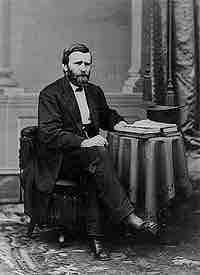Most lobbying during the nineteenth century happened within state legislatures. While the federal government had a larger jurisdiction, it did not handle many matters pertaining to the economy. The state governments did much more legislating than the federal government. When lobbying did happen, it was often "practiced discreetly" with little or no public disclosure. By one account, more intense lobbying in the federal government happened from 1869 to 1877 during the administration of President Grant near the start of the so-called Gilded Age. The most influential lobbyists wanted railroad subsidies and a tariff on wool. At the same time in the Reconstruction South, lobbying was intense near the state legislatures, especially regarding railroad subsidies, but it also happened in other areas, such as gambling. For example, Charles T. Howard of the Louisiana State Lottery Company actively lobbied state legislators and the governor of Louisiana for the purpose of getting a license to sell lottery tickets.

President Grant
President Ulysses S. Grant was in office during a period of more intense lobbying in the federal government between 1869 and 1877.
But, it was not until the 20th century that lobbying the Executive Branch really emerged as a widespread issue with several new political trends in the government, including:
- Expensive campaigns. Winning reelection meant spending huge sums on expensive media, particularly television advertising. Congresspersons seeking reelection found themselves having to spend much of their time raising money instead of governing. In 1976, the average cost of running for a House seat was 86,000. By 2006, it was 1.3 million. Running for Senate was even pricier, with an average cost in 2006 of $8.8 million.
- Increased Complexity. This was partly the result of a continuing shift of legislative authority from state governments to Washington and partly the result of new technologies and systems. It became difficult for voters or watchdog groups to monitor this activity since it became harder to follow or even comprehend. Complexity encouraged more specialized lobbying, often with more than one agency affected by any one piece of legislation. It also encouraged lobbyists to become familiar with the intricate details and history of many issues. Executive branch agencies added a new layer of rule-making to congressional legislation. The economy expanded.
In many ways, lobbying the Executive Branch is similar to any other branch of the U.S. government and is thereby regulated by laws pertaining to disclosure discussed in Regulation Congressional Lobbyists. However, it is true that many executive branch agencies have the power to write specific rules and are a target of lobbying. Federal agencies, like the State Department, make rules to give aid money to countries like Egypt. In fact, an Egyptian-American businessman named Kais Menoufy organized a lobby to try and halt U.S. aid to Egypt.
Further complicating the relationship between lobbying and the Executive Branch is the fact that it is possible for one level of government to lobby another level. The District of Columbia, seeking better voting rights for its citizens, has been lobbying Congress and the president for greater power—including possible statehood or voting representation in Congress. An assessment in 2011 suggested that the district needed to rethink its lobbying strategy, since its past efforts have only had "mixed results."